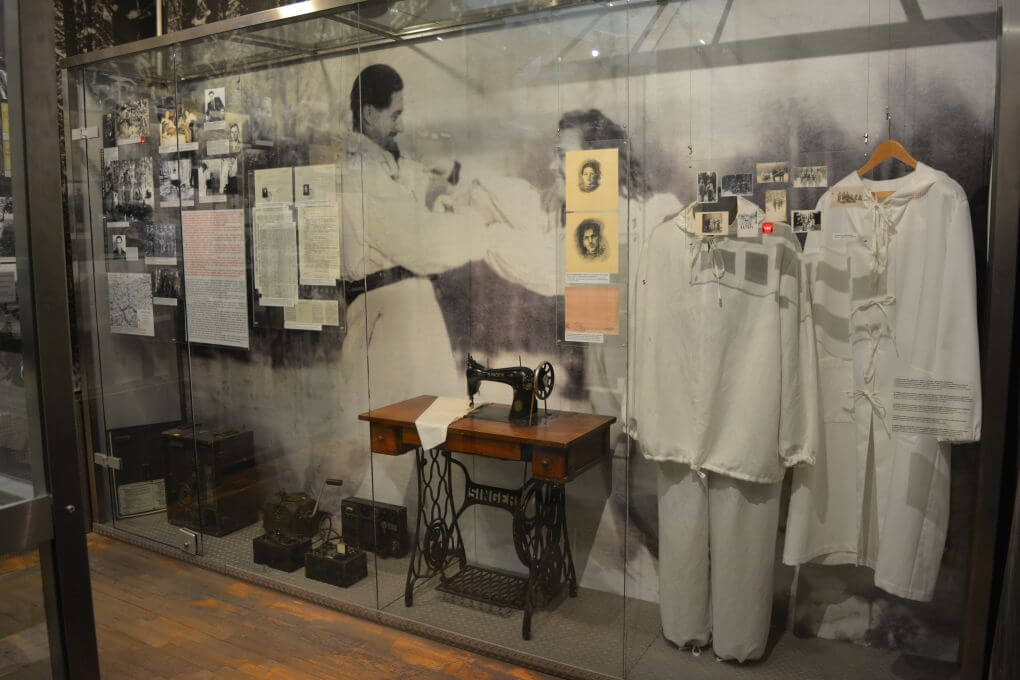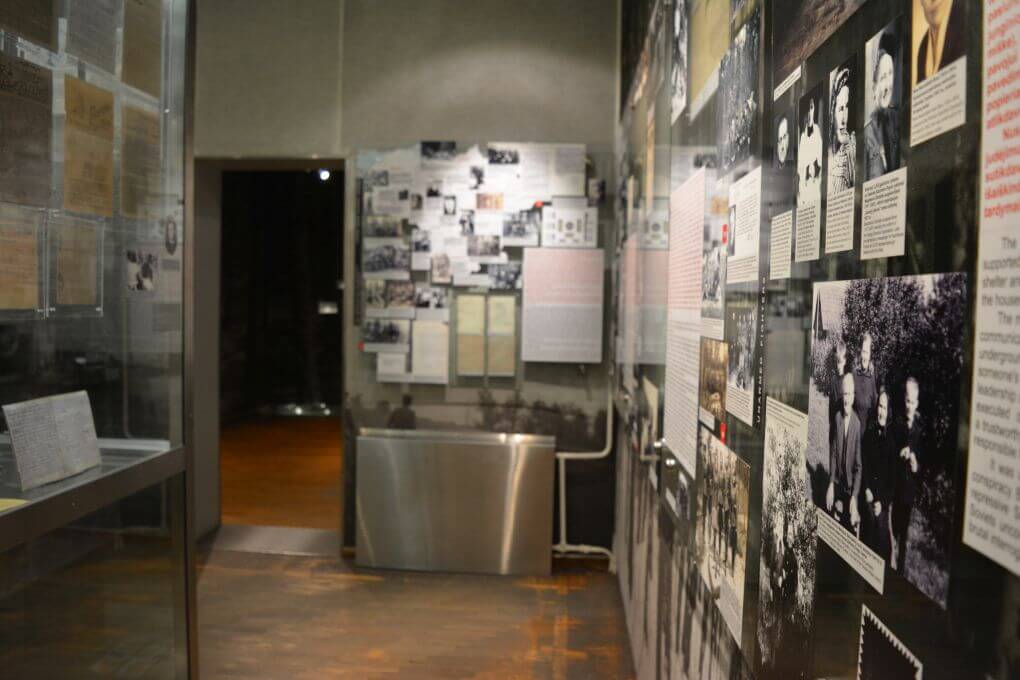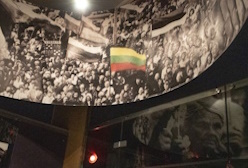The partisan war: 1944–1953
Pupils, students and pensioners (with ID) – 3 €.
Main Information
After the German occupation, in July 1944, the Soviet army re-entered Lithuania. Nine years of organised partisan warfare for the restoration of an independent state began in the country. Individual partisans managed to remain in hiding until mid-1960’s. The last partisan, Stasys Guiga, died of natural causes in 1986.
The exhibition presents the territorial structure and military organisation of the partisan formations, aspirations of freedom fighters, their daily operations and everyday life. The exhibition includes authentic documents of the Movement of the Struggle for the Freedom of Lithuania, periodicals and other publications, manuscripts, personal belongings, photographs capturing faces of freedom fighters, their rare celebrations, and the moments of bidding farewell to their friends in arms.
The first years of struggle
The second Soviet occupation took the Lithuanian resistance organisations by surprise. Under new circumstances, the Lithuanian Freedom Army’s leadership demonstrated the highest resolve. It urged its members to stay in the country and took concrete steps to organise resistance: it reorganised its structure, stockpiled weapons, and mobilised fighters. Over 200 members of the organisation were sent to German intelligence schools in the hope to train them for partisan warfare there.
Members of other anti-Nazi resistance organisations also tried to organise themselves and to find contacts with each other, however, in the absence of a single leading underground centre in the country, the anti-Soviet resistance was rather spontaneous.
By the end of 1944 and beginning of 1945, there may have been around 30,000 men who took to the forests. Only a few of them were professional military staff, and the majority of these were junior officers. They became commanders of larger partisan groups – formations, districts, areas, while smaller combat units were led only by farmers, teachers, and upper-secondary school students who either had completed compulsory military service or had no military training.
Partisan military organisation
Lithuanian partisans, after taking over and continuing the traditions of the Lithuanian army, operated as a military structure. At the beginning, the provisional regulations and rules governing the activities of partisans were drawn up by commanders of larger individual formations, following the usual example of the army of independent Lithuania. A larger partisan group (formation, district, area) had each its own headquarters made up of the commander of the respective formation, the chief of staff and the heads of departments (formation, organisation, mobilisation, intelligence, information, etc.). In some districts, partisans were given military training, and those who passed an examination were awarded a military rank or were promoted.
Commanders of partisan formations demanded from their fighters the unconditional respect for military discipline and the established norms of behaviour, and tried in various ways to prevent disorder, and arbitrariness. However, as in every war, violence and arbitrariness towards the civilian population could not be avoided.
Establishment of the Movement for the Struggle of Freedom of Lithuania
The leaders of both partisan formations and underground organisations active in the cities realised the necessity of having a common underground leadership that would define the political strategy of the struggle, be able to represent the underground and seek support abroad. However, in the underground and with the army and agents of the special services rampant throughout the country, this was not an easy task. The first attempts to establish a common leadership were, therefore, not successful.
It was only after almost five years of struggle, when the resistance was beginning to weaken, that a common military and political leadership centre of the resistance was established. In February 1949, a congress of representatives of partisan districts merged the armed anti-Soviet resistance into a single organisation – the Movement for the Struggle of Freedom of Lithuania (LLKS). The congress adopted military-political documents legalising the Sąjūdis as the organisation leading the political and military struggle for the liberation of the nation and set up a council and its presidium. The political declaration adopted by the Council of the LSSL on 16 February 1949 proclaimed that the supreme legitimate authority in Lithuania was exercised by the partisan leadership, and that the aim of their struggle was the restoration of an independent democratic Republic of Lithuania.
The daily struggle
Partisan commanders, aware of what partisans could achieve, generally agreed to spare the spiritual and material resources of the nation. After the losses during the first years of struggle, they abandoned risky campaigns against military garrisons stationed in towns and avoided going into battle when the enemy had a clear superiority. Military actions were more often organised against the administrative institutions of the occupation forces, preventing them from holding elections, establishing collective farms, and fighting against collaborators. Military and propaganda measures were used to oppose sovietisation, to foster patriotic sentiment among the population, and to encourage civil disobedience to the occupation authorities.
Spiritual life
The partisan leadership made various efforts to make the daily life of partisans as spiritual as possible: in the evenings, songs were sung around the campfires, plays were performed, joint prayers were said. Circumstances permitting, partisans celebrated conventional national and religious festivals and risking their lives buried their killed friends. Many fighters attempted writing – they wrote memoirs, poems, descriptions of battles, trying to express and describe their experiences in unusual words.
Love for their country, belief in the righteousness and meaningfulness of their struggle sustained the fighting spirit and helped them to persevere in the face of harsh reality.
Publishing
Freedom fighters resisted occupation not only with weapons but also with their writings. During the partisan warfare, Lithuania saw the publication of dozens of titles of periodicals and non-periodical publications.
The themes of the partisan press were very diverse. As the occupation newspapers spread lies and propaganda, the public behind the Iron Curtain was first and foremost informed about international events. Partisan publications remained the only ones that nurtured national culture and traditions. In their articles, partisans explained the anti-human nature of the totalitarian system, urged people not to forget the nation’s spiritual traditions and history, and not to succumb to the propaganda of communist ideology. The aim was to promote love for the Homeland, citizenship, morality, and to leave behind the knowledge of the history of the partisan struggles and the crimes committed by the Bolsheviks.
Defenceless fighters
Had it not been for the support of mostly rural population, the Lithuanian partisans would not have survived for so long, for almost ten years. The villagers would give the partisans clothes, food, shelter, and provide for their necessities. Relatives of persecuted freedom fighters found refuge with people who sympathised with the partisans.
Partisan liaisons can also be regarded as unarmed fighters. They delivered packages of documents and publications, warned of imminent danger, and brought medicines.
It was very difficult to conceal contacts with the partisans due to lack of conspiratorial skills. As the movement was weakening and the ranks of the partisans were thinning out, more and more people agreed to become informers and agents of the repressive agencies. Like the partisans, they were subjected to harsh interrogations, followed by Gulag prisons and camps.
Through the Iron Curtain
For partisans fighting on their own on the territory of Lithuania it was very important to establish contacts with Western countries and Lithuanian diaspora organisations abroad. Both material and political support was expected from them. The freedom fighters wanted the world to know about the partisan war that aimed to restore the independent state of Lithuania.
The first partisans, Jurgis Krikščiūnas and Juozas Lukša, broke through the Iron Curtain into the West in the spring of 1947. In December 1947, Kazimieras Pyplys and Juozas Lukša followed suit. They brought along a large amount of documentary material about the repressions by the Soviet occupation forces and freedom struggles in their country, which they distributed in the Western media with the help of the diaspora, and they also forwarded a letter from the Lithuanian Catholics to the Pope. Pyplys and Lukša immediately began arranging for their return to the struggling country, but this proved to be more difficult than expected. It was a year and a half later for K. Pyplys, and more than two and a half years later for J. Lukša that they managed to return to Lithuania by paratrooper parachute landing. Here they were met by their friends in arms, whose ranks had thinned out by that time, but which still had not lost their resolve, and were awaiting hopeful news from the West.
In 1950-1953, a few more paratroopers and individual radio operators from the West reached Lithuania, but almost all of them suffered a tragic fate: some were killed, others were shot, some ended up in prisons or labour camps. There were some who agreed to collaborate with the Soviet security forces.
Exposition Location

Exposition „The partisan war: 1944–1953“
Location: First Floor


















